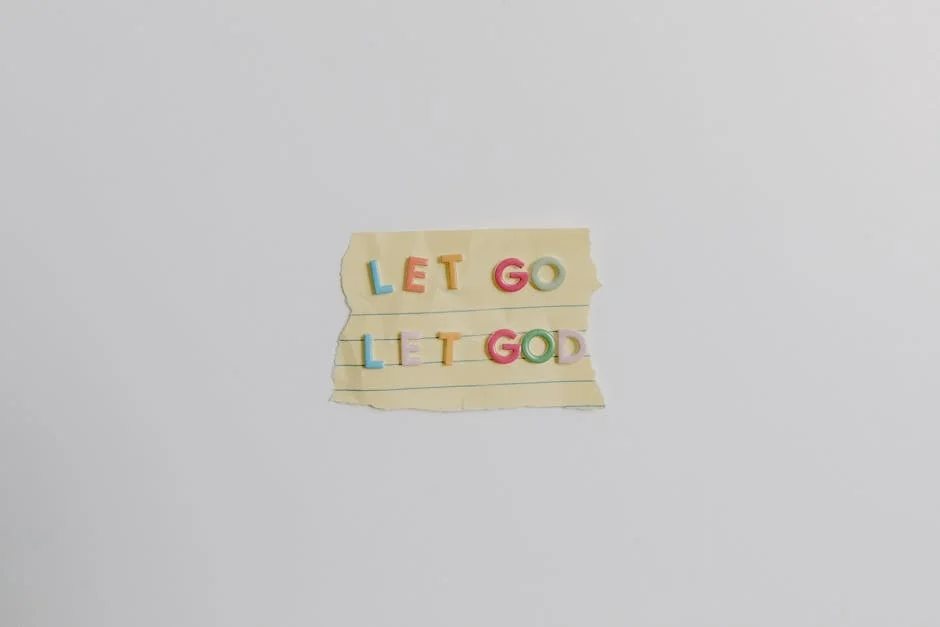Do you ever lie awake at night, replaying a stressful conversation from the day or worrying about a future you can't control? This mental tug-of-war, the exhausting effort of holding on, is a universal human experience. We cling to past hurts, anxious thoughts, and the desperate need to manage every outcome, only to find ourselves drained and stuck. But what if there was a way to release that grip without giving up? This is the profound practice of mindfulness and letting go.
Far from being about suppression or avoidance, this powerful combination offers a gentle path to true freedom. It’s not about pushing difficult feelings away, but about learning to meet them with compassionate awareness, allowing them to pass through you without taking root. In this guide, we’ll explore the surprising science of why we cling so tightly, uncover the tangible benefits of release—from reduced anxiety to deeper sleep—and equip you with practical, step-by-step techniques to transform your relationship with your thoughts and emotions. Ready to lighten your load? Let’s begin.
Why We Cling: The Psychology of Holding On
To understand how to let go, we must first understand why we hold on so fiercely. Our tendency to cling isn't a personal failing; it's a hardwired survival mechanism. Our brain's limbic system, the seat of emotion and memory, is designed to seek pleasure and avoid pain. This was incredibly useful for our ancestors avoiding predators, but in the modern world, it often misfires, causing us to cling to emotional patterns that no longer serve us.
Several key psychological drivers fuel this behavior:
- The Illusion of Control: We often believe that by worrying or ruminating, we can somehow influence or control an outcome. Holding onto a grudge might feel like a form of justice, and clinging to anxiety about a presentation might feel like preparation. This
illusion of controlcreates a false sense of security, making the unknown seem more manageable, even if the process is painful. - Identification with Our Stories: We become fused with our thoughts and narratives. A thought like "I'm not good enough" shifts from being a passing mental event to a core truth of our identity. Letting go of the associated pain then feels like letting go of a part of ourselves, which the ego fiercely resists.
- Fear of the Unknown: The familiar, even when it's painful, is often perceived as safer than the unknown. A stressful job, a toxic relationship, or a well-worn path of self-criticism is a known entity. Releasing it means stepping into a void of uncertainty, which can trigger a primal fear response.
Recognizing that your clinging is not a choice but a deep-seated, automatic reaction is the first step toward compassionately disengaging from it.
The Liberating Link: How Mindfulness Makes Letting Go Possible
If letting go is the goal, mindfulness is the vehicle that takes you there. Many people misunderstand letting go as an act of forceful rejection—trying to toss an unwanted thought out of their mind. But as anyone who has tried not to think of a pink elephant knows, this only makes the thought stronger.
Mindfulness reframes the entire process. Mindfulness is the practice of paying attention to the present moment with an attitude of open, non-judmental curiosity. It’s not about emptying the mind, but about changing your relationship with its contents.
Here’s the liberating link: Mindfulness creates a critical space between you and your experience. Instead of being your anger (e.g., "I am angry"), you learn to observe it (e.g., "I am noticing the sensation of anger"). From this place of observation, letting go becomes a natural, conscious choice rather than a forced effort.
Imagine your mind is the vast, open sky. Your thoughts, emotions, and sensations are the weather—clouds, rain, sunshine, and storms. You are not the storm; you are the sky that holds it. The storm may be intense, but the sky itself remains unchanged. Mindfulness teaches you to be the sky. You observe the weather patterns without getting caught in them, trusting that they will eventually pass. Letting go, then, is simply the act of allowing the weather to move through without trying to control it or cling to it.
The Tangible Benefits of Letting Go Through Mindfulness
Cultivating this skill is more than a philosophical exercise; it yields concrete, life-changing benefits. When you stop pouring energy into clinging, that energy is freed up for living a richer, more peaceful life.
- Reduced Stress and Anxiety: The body's stress response, fueled by cortisol, is often activated by our resistance to what is. When you stop fighting reality and learn to let go of the need to control the uncontrollable, your nervous system can downshift from a state of high alert. This leads to a significant reduction in chronic stress and anxiety, which you can further explore with these proven ways to decrease stress and anxiety.
- Improved Emotional Regulation: By observing emotions without immediate reaction, you break the chain between trigger and outburst. You gain the power to respond wisely instead of reacting impulsively. Emotions arise, are acknowledged, and dissipate without hijacking your entire day.
- Greater Mental Clarity and Focus: A mind cluttered with regrets about the past and worries about the future has little room for the present. Letting go clears this mental clutter, leading to improved concentration, enhanced creativity, and sharper problem-solving abilities.
- Enhanced Resilience: Life is inherently unpredictable. The practice of mindfulness and letting go builds psychological flexibility, allowing you to adapt to change, navigate challenges, and bounce back from setbacks with greater ease. You become like a flexible tree that bends in the storm rather than a rigid one that breaks.
- Deeper and More Restful Sleep: When you can let go of the day's stresses and tomorrow's anxieties at bedtime, your mind and body can truly relax. This practice is a powerful antidote to the racing thoughts that so often cause insomnia, paving the way for more restorative sleep.
A Practical Toolkit: Mindfulness Techniques for Letting Go
Knowing the theory is one thing; integrating it into your life is another. This toolkit offers concrete practices to help you cultivate the art of mindful release. Approach each one with a spirit of gentle curiosity, not rigid expectation.
The Body Scan for Releasing Physical Tension
Our mental clinging often manifests as physical tension in the body. The body scan brings awareness to these holding patterns, allowing them to soften.
- How to Practice: Find a comfortable position, lying down or sitting upright. Close your eyes and bring your attention to the tips of your toes. Notice any sensations there—tingling, warmth, pressure, or nothing at all. Without trying to change anything, simply observe.
- Slowly, gradually, move your attention up through your body: to the arches of your feet, your heels, your ankles, and so on, all the way to the top of your head.
- When you encounter an area of tension or tightness, breathe into that space. On your inhale, imagine sending breath to that area. On your exhale, imagine the tension releasing and melting away. The goal isn't to force relaxation, but to offer it an invitation to let go.
RAIN: A Meditation for Difficult Emotions
RAIN is a powerful mindfulness acronym developed by meditation teacher Tara Brach. It’s a direct path for working with challenging feelings.
- R - Recognize: The first step is to simply recognize what is happening. Name the emotion silently to yourself: "This is anger," "This is fear," "This is sadness."
- A - Allow: Instead of fighting the feeling, consciously allow it to be there. This doesn't mean you like it, but you stop resisting its presence. You might say, "I allow this feeling of anxiety to be here."
- I - Investigate: Bring a gentle, curious attention to the emotion. Where do you feel it in your body? What are its qualities? Is it hot, cold, heavy, sharp? Is it constant or does it pulse? Investigate without analyzing or creating a story about it.
- N - Nurture (or Non-Identification): This final step is about offering compassion. Place a hand on your heart and offer yourself a kind word. Then, remind yourself that this emotion is a passing experience, not your identity. There is anger, but you are not the anger. This is the essence of non-identification and letting go.
Thought Labeling and Cloud Watching
This practice helps you detach from the stream of your thoughts.
- How to Practice: Sit in meditation and simply watch the flow of your thoughts. As each one arises, gently label it and let it pass.
- For example, if you start thinking about your to-do list, silently note, "planning," and return to your breath. If a memory arises, note, "remembering." If a judgment comes, note, "judging."
- You can enhance this by visualizing your thoughts as leaves floating down a stream or clouds passing in the sky. You acknowledge each one ("Ah, a worry cloud"), but you don't jump on the leaf or grab the cloud. You let the current of your awareness carry them away.
The Letting Go Breath
This is a simple yet profound technique you can use anywhere, anytime you feel yourself gripping tightly.
- How to Practice: Take a slow, deep breath in through your nose. As you exhale through your mouth, either slowly or with a soft sigh, consciously release the tension you are holding.
- Mentally pair the exhale with a silent keyword or phrase that supports release, such as "Let go," "Release," "Relax," or "It's passing."
- Feel a sense of softening and letting go throughout your entire body with each out-breath. Just three to five of these intentional letting-go breaths can reset your nervous system in a moment of stress.
Integrating mindfulness and meditation and letting go is a journey, not a destination. It’s a gentle, daily returning to the present moment and releasing the struggle with what you find there. Some days will feel easier than others, and that’s perfectly normal. The practice itself—the kind, consistent returning to awareness—is where the freedom lies. Start small, be patient with yourself, and trust that each conscious breath of release is a step toward a lighter, more peaceful way of being.
In summary, the practice of mindfulness offers a powerful pathway to the art of letting go. By cultivating present-moment awareness, we learn to observe our thoughts, emotions, and attachments without immediate judgment or reaction. This creates a crucial space between stimulus and response, allowing us to consciously release the grip on what no longer serves us—be it past regrets, anxieties about the future, or rigid expectations. The key takeaway is that letting go is not an act of giving up, but a courageous process of making room for new growth and peace. This journey requires consistent practice, yet its rewards are profound: reduced stress, greater emotional resilience, and a deeper sense of contentment with life as it unfolds. Begin by integrating small moments of mindful awareness into your daily routine, and trust that each conscious breath is a step toward a lighter, more liberated way of being. You possess the capacity to find freedom by simply letting things be.


